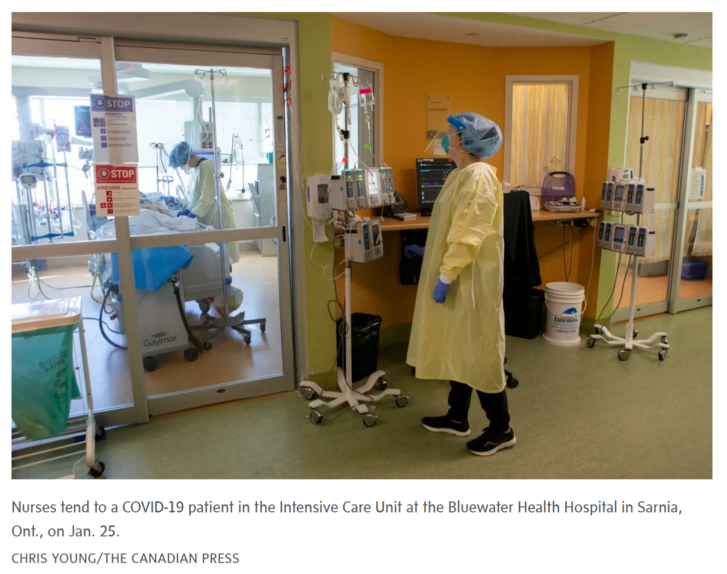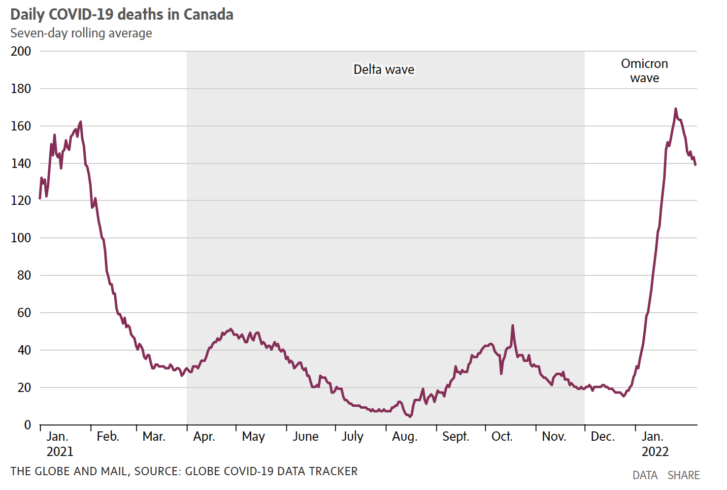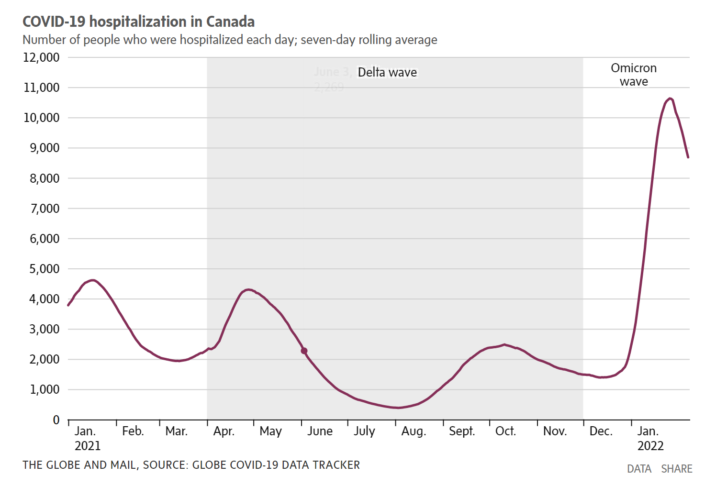People infected with the Omicron variant of SARS-CoV-2 are less likely to die or experience severe outcomes compared with those infected with the Delta variant, emerging research shows.
However, the variant’s hypertransmissibility has led to daily death numbers that have eclipsedthose of the previous wave, and a record number of hospitalizations, with Canada’s older population still at highest risk.
Federal and provincial governments have begun to signal a turning point in the fight against COVID-19, with some leaders pointing to the variant’s relatively less severe outcomes as one reason to lift remaining restrictions within weeks. But experts caution that measures should be eased only when governments have done everything possible to protect the most vulnerable residents.

Samir Sinha, director of geriatrics at Sinai Health and the University Health Network, said many older people also want restrictions to end, but feel conflicted. “They are also very clearly aware that there are a number of older people who are not being supported, or are not necessarily being protected in the way that is needed, for society to reopen safely.”
Canada recorded nearly 170 deaths a day during the peak of the Omicron wave in late January, based on a seven-day rolling average. This compares with a peak of about 50 a day during the Delta wave.

A study of nearly 70,000 people in southern California infected with either Omicron or Delta found that those with Omicron were 91 per cent less likely to die of the disease and 74 per cent less likely to need critical care (mainly admission to intensive care units). The median duration of hospital stay for those with Omicron was about 70 per cent shorter than for those with Delta, or about 3.4 days.
Reductions in disease severity associated with Omicron were evident among vaccinated and unvaccinated patients and those with or without a prior COVID-19 infection, wrote the authors of the study, which has not yet been peer-reviewed.

The authors note that while such findings are encouraging, the higher transmissibility of Omicron, as well as the fact that prior infection and vaccination are not as effective in fighting off the variant, have led to unprecedented surges of COVID-19 that have overwhelmed health care systems and led to high numbers of hospitalizations and deaths.
“Thus, implementation of concurrent prevention strategies including vaccination, masking, and appropriate infection mitigation strategies remains important to curb transmission, decrease morbidity and mortality, and reduce burden on health systems nationwide,” the authors wrote.
Limited Canadian data comparing variants show a similar pattern. British Columbia this month released data on hospitalizations by variant, based on a sample of 511 Delta cases, and 1,194 Omicron cases, between Nov. 28, 2021, and Jan. 28, 2022.
Of those hospitalized with Delta, 37.5 per cent needed critical care, and 14.2 per cent died. In comparison, 13.1 per cent of those hospitalized with Omicron required critical care, and 6.5 per cent died. The median length of hospital stay was seven days for Delta, and four days for Omicron.
Reviews of 550 cases of people across B.C. admitted to hospital with COVID-19 show that 44 per cent who were hospitalized for reasons unrelated to the virus tested positive while admitted. About 61.5 per cent of people hospitalized with Omicron were admitted for other reasons, compared with 22.5 per cent with Delta.
Provincial Health Officer Bonnie Henry said the findings indicate how widespread Omicron has become.
“As Omicron has spread in the communities, we are more likely to [detect] it when people are admitted to hospital for other reasons, and those other reasons are what keep them in hospital,” she said.
The reviews also showed that the proportion of people aged 80 and older is higher among Omicron cases than Delta cases, at 30.9 per cent and 13.8 per cent, respectively. Dr. Henry said this is because people 80 and up are still at highest risk of severe illness from COVID-19, and are more likely to have other health conditions as well.
Unvaccinated people also made up a larger proportion of hospitalized Delta cases than Omicron cases, at 67.7 per cent and 23.4 per cent, respectively.
In Ontario, a study of more than 9,000 cases between Nov. 22 and Dec. 24, 2021, found that the risk of hospitalization or death was 59 per cent lower for Omicron compared with Delta, while the risk of ICU admission or death was 81 per cent lower and the risk of death 88 per cent lower.
The report by Public Health Ontario said that despite Omicron’s probable reduction in severity, the number of hospitalizations could still be significant owing to Omicron’s transmissibility.
A spokesperson for Quebec’s national public health institute said work is under way to compare by variant, but available data has shown that older people make up a larger proportion of those with severe outcomes during the Omicron wave.
Provincial data show that people aged 80 and up account for 32.8 per cent of hospitalizations and 63 per cent of deaths during Omicron. In comparison, this group accounted for 24.4 per cent of hospitalizations and 48.4 per cent of deaths in the Delta-driven fourth wave.
People aged 60 and older account for about 90 per cent of all COVID-19 deaths in Canada, a trend that has been consistent throughout the pandemic. Dr. Sinha said part of the increase in deaths during the Omicron wave may be attributed to missed opportunities to further protect this population.
As of Feb. 7, about 94 per cent of Canadians aged 60 and up had received two vaccine doses, but only 74 per cent had received a third. Before Omicron became dominant in December, only about a quarter had received a booster, Dr. Sinha noted.
“The rollout of boosters became quite patchy; there wasn’t the same level of urgency that preceded previous vaccine rollouts,” he said. “I’m in favour of lifting restrictions further if we can say we have done everything humanly possible to make sure that every older citizen has had access and an opportunity to get their booster doses.”
Article From: Globe and Mail
Author: ANDREA WOO

